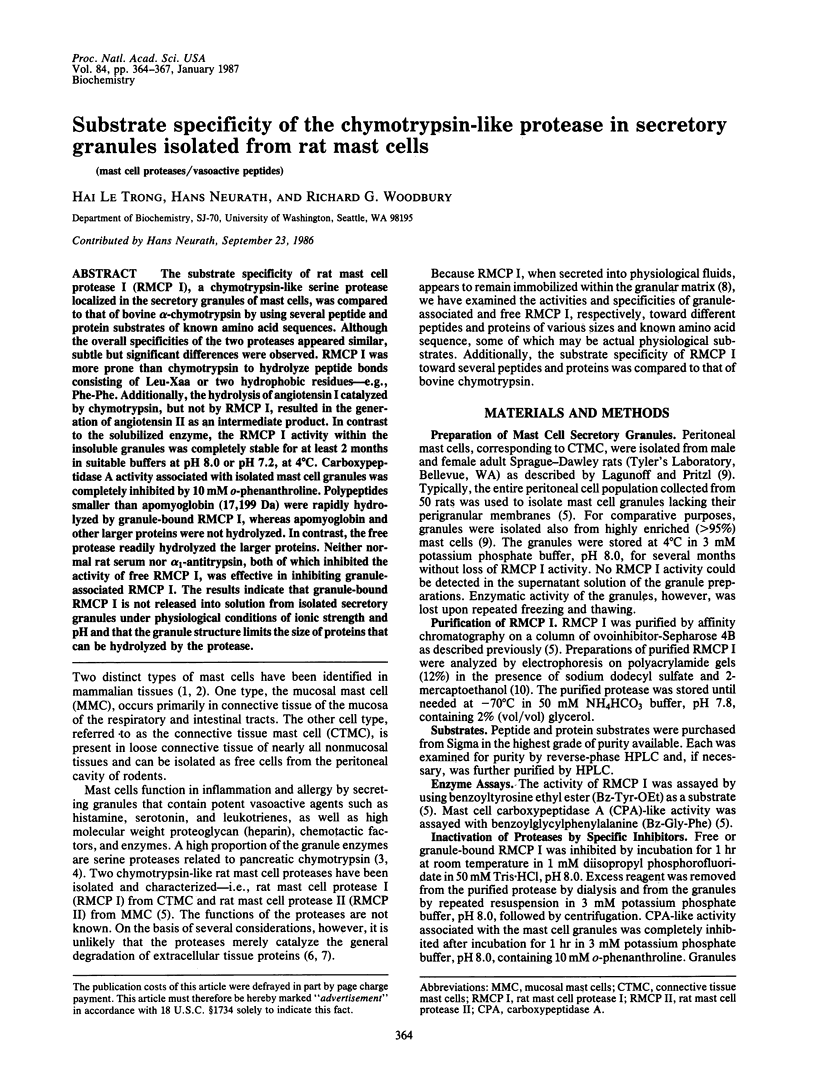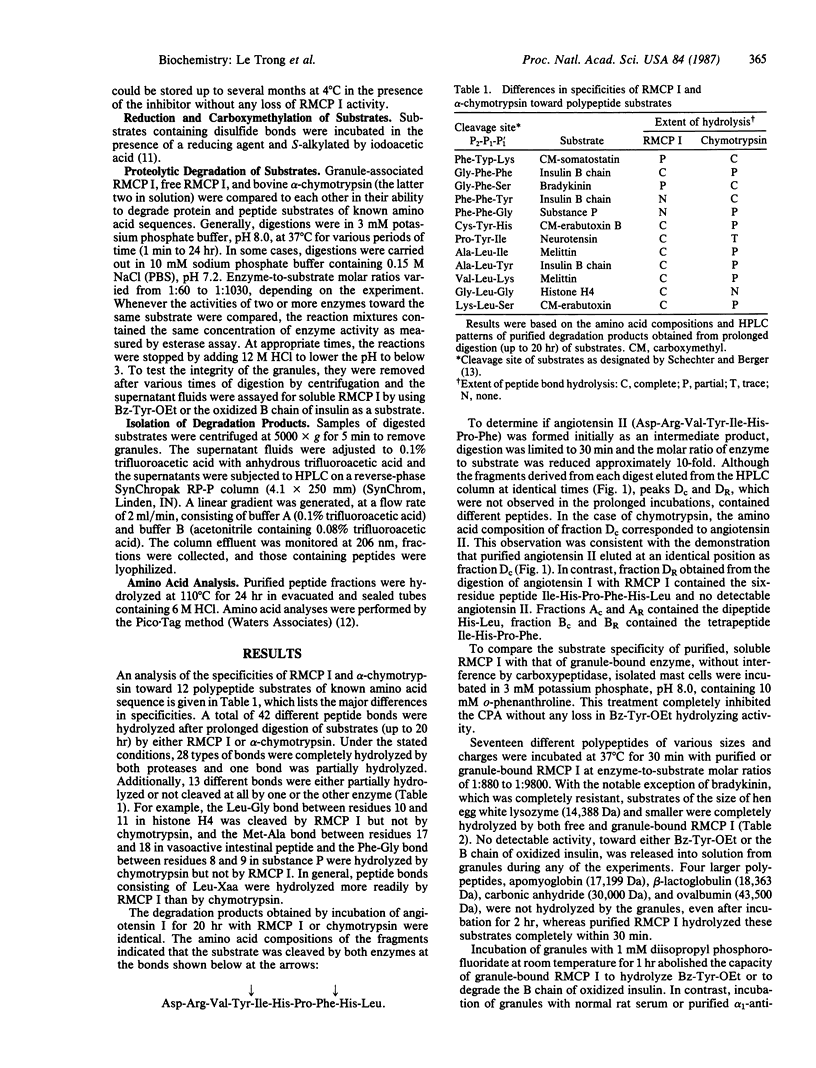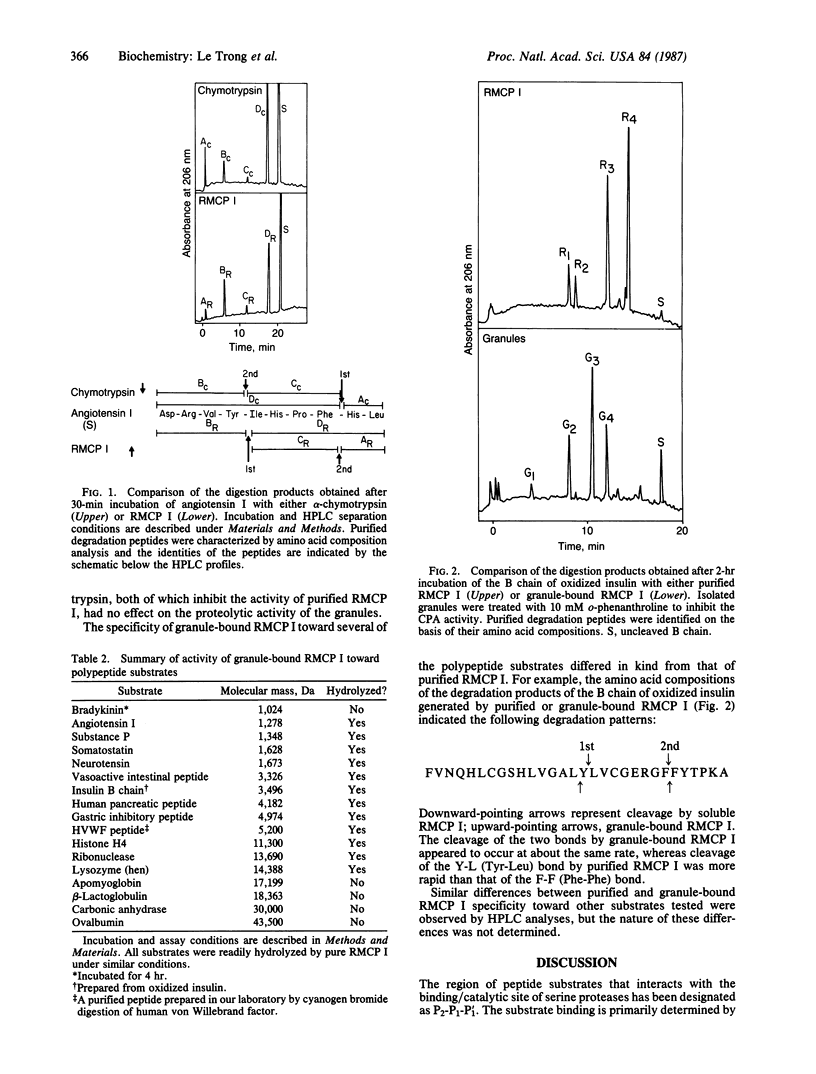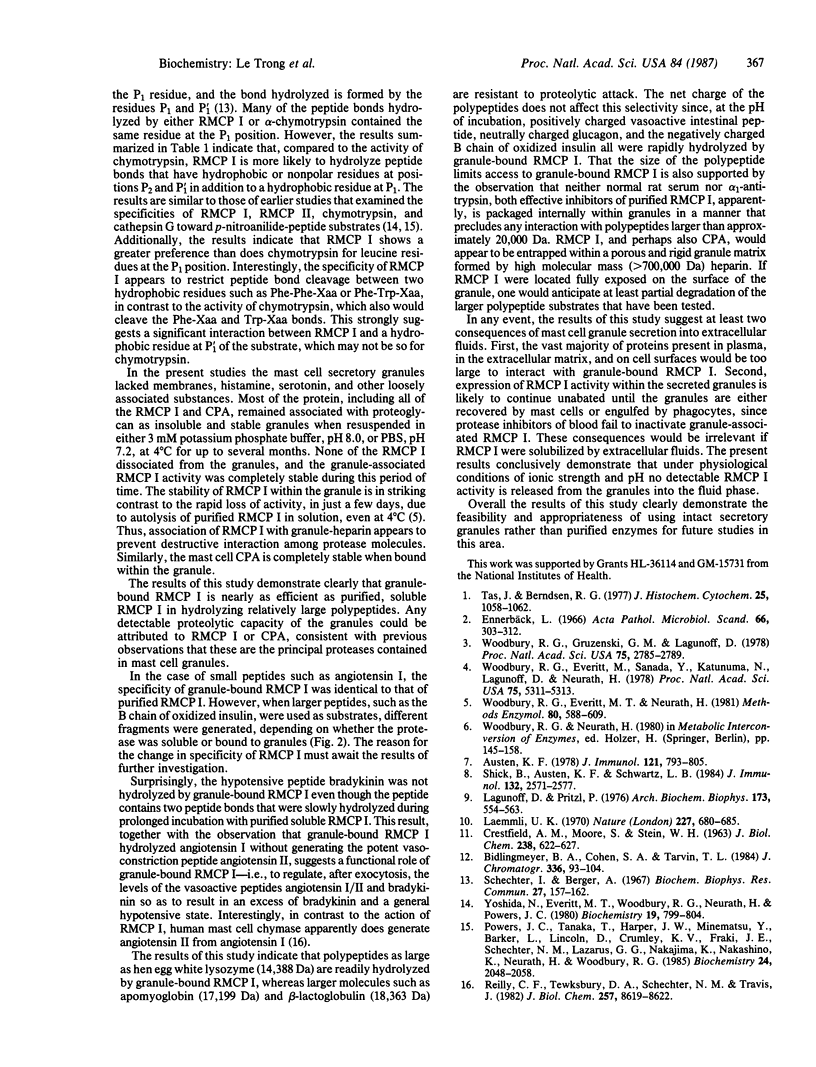Abstract
The substrate specificity of rat mast cell protease I (RMCP I), a chymotrypsin-like serine protease localized in the secretory granules of mast cells, was compared to that of bovine alpha-chymotrypsin by using several peptide and protein substrates of known amino acid sequences. Although the overall specificities of the two proteases appeared similar, subtle but significant differences were observed. RMCP I was more prone than chymotrypsin to hydrolyze peptide bonds consisting of Leu-Xaa or two hydrophobic residues--e.g., Phe-Phe. Additionally, the hydrolysis of angiotensin I catalyzed by chymotrypsin, but not by RMCP I, resulted in the generation of angiotensin II as an intermediate product. In contrast to the solubilized enzyme, the RMCP I activity within the insoluble granules was completely stable for at least 2 months in suitable buffers at pH 8.0 or pH 7.2, at 4 degrees C. Carboxypeptidase A activity associated with isolated mast cell granules was completely inhibited by 10 mM o-phenanthroline. Polypeptides smaller than apomyoglobin (17,199 Da) were rapidly hydrolyzed by granule-bound RMCP I, whereas apomyoglobin and other larger proteins were not hydrolyzed. In contrast, the free protease readily hydrolyzed the larger proteins. Neither normal rat serum nor alpha 1-antitrypsin, both of which inhibited the activity of free RMCP I, was effective in inhibiting granule-associated RMCP I. The results indicate that granule-bound RMCP I is not released into solution from isolated secretory granules under physiological conditions of ionic strength and pH and that the granule structure limits the size of proteins that can be hydrolyzed by the protease.
Full text
PDF



Selected References
These references are in PubMed. This may not be the complete list of references from this article.
- Austen K. F. Homeostasis of effector systems which can also be recruited for immunologic reactions. J Immunol. 1978 Sep;121(3):793–805. [PubMed] [Google Scholar]
- Bidlingmeyer B. A., Cohen S. A., Tarvin T. L. Rapid analysis of amino acids using pre-column derivatization. J Chromatogr. 1984 Dec 7;336(1):93–104. doi: 10.1016/s0378-4347(00)85133-6. [DOI] [PubMed] [Google Scholar]
- CRESTFIELD A. M., MOORE S., STEIN W. H. The preparation and enzymatic hydrolysis of reduced and S-carboxymethylated proteins. J Biol Chem. 1963 Feb;238:622–627. [PubMed] [Google Scholar]
- Enerbäck L. Mast cells in rat gastrointestinal mucosa. 2. Dye-binding and metachromatic properties. Acta Pathol Microbiol Scand. 1966;66(3):303–312. doi: 10.1111/apm.1966.66.3.303. [DOI] [PubMed] [Google Scholar]
- Laemmli U. K. Cleavage of structural proteins during the assembly of the head of bacteriophage T4. Nature. 1970 Aug 15;227(5259):680–685. doi: 10.1038/227680a0. [DOI] [PubMed] [Google Scholar]
- Lagunoff D., Pritzl P. Characterization of rat mast cell granule proteins. Arch Biochem Biophys. 1976 Apr;173(2):554–563. doi: 10.1016/0003-9861(76)90292-7. [DOI] [PubMed] [Google Scholar]
- Powers J. C., Tanaka T., Harper J. W., Minematsu Y., Barker L., Lincoln D., Crumley K. V., Fraki J. E., Schechter N. M., Lazarus G. G. Mammalian chymotrypsin-like enzymes. Comparative reactivities of rat mast cell proteases, human and dog skin chymases, and human cathepsin G with peptide 4-nitroanilide substrates and with peptide chloromethyl ketone and sulfonyl fluoride inhibitors. Biochemistry. 1985 Apr 9;24(8):2048–2058. doi: 10.1021/bi00329a037. [DOI] [PubMed] [Google Scholar]
- Reilly C. F., Tewksbury D. A., Schechter N. M., Travis J. Rapid conversion of angiotensin I to angiotensin II by neutrophil and mast cell proteinases. J Biol Chem. 1982 Aug 10;257(15):8619–8622. [PubMed] [Google Scholar]
- Schechter I., Berger A. On the size of the active site in proteases. I. Papain. Biochem Biophys Res Commun. 1967 Apr 20;27(2):157–162. doi: 10.1016/s0006-291x(67)80055-x. [DOI] [PubMed] [Google Scholar]
- Schick B., Austen K. F., Schwartz L. B. Activation of rat serosal mast cells by chymase, an endogenous secretory granule protease. J Immunol. 1984 May;132(5):2571–2577. [PubMed] [Google Scholar]
- Tas J., Berndsen R. G. Does heparin occur in mucosal mast cells of the rat small intestine? J Histochem Cytochem. 1977 Sep;25(9):1058–1062. doi: 10.1177/25.9.71326. [DOI] [PubMed] [Google Scholar]
- Woodbury R. G., Everitt M. T., Neurath H. Mast cell proteases. Methods Enzymol. 1981;80(Pt 100):588–609. doi: 10.1016/s0076-6879(81)80047-x. [DOI] [PubMed] [Google Scholar]
- Woodbury R. G., Everitt M., Sanada Y., Katunuma N., Lagunoff D., Neurath H. A major serine protease in rat skeletal muscle: evidence for its mast cell origin. Proc Natl Acad Sci U S A. 1978 Nov;75(11):5311–5313. doi: 10.1073/pnas.75.11.5311. [DOI] [PMC free article] [PubMed] [Google Scholar]
- Woodbury R. G., Gruzenski G. M., Lagunoff D. Immunofluorescent localization of a serine protease in rat small intestine. Proc Natl Acad Sci U S A. 1978 Jun;75(6):2785–2789. doi: 10.1073/pnas.75.6.2785. [DOI] [PMC free article] [PubMed] [Google Scholar]


